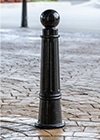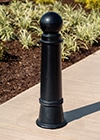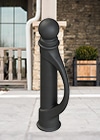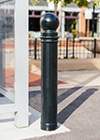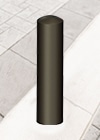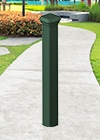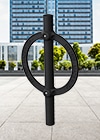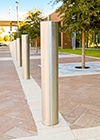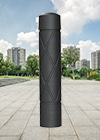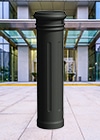As with any component of a construction project, the true total cost to buy, ship and install bollards is harder to pin down than the flat sticker price of the products themselves.
To get a sharper image of the total project cost, you must also consider where the products are made, how (and how far) they travel to their final destination and how their function informs installation method and installation cost.

Bollard cost starts with sticker price
But it still makes sense to start with the base price of the fixtures, and this can vary widely. Here’s a very general rundown:
A no-frills plastic bollard with no accompanying crash ratings can be had for less than $200 per unit. You can even find them on your favorite e-retailer website. Of course, you’ll pay workers to install them, and those rates vary based on where you’re located and how complex the installation is.
Decorative cast iron or steel bollards with no added crash protection component will vary in cost depending on how they’re finished and what customizations, if any, are added on. But a crude number might be $600 to $1,000 per unit when accounting for labor.
Protective bollards offering maximum crash resistance are made of sturdier materials and require digging and pouring foundations. Owing to this added complexity, all-in cost for these bollards could approach $4,000 each.
(Bollard installation is a major project price driver. We cover it in more detail below, but you can also learn what you need to know about that in this article.)
How much do bollards from BollardsUSA cost?
Similar to the general rundown above, bollards from BollardsUSA vary in cost. Influential factors include:
- Specified function. Are they purely decorative? Must they be safety-rated? Must they perform both roles at once?
- Removability. Permanently installed bollards require generally less hardware compared to those that can be removed.
- Customizability. BollardsUSA offers customizations including logo stamping and a wide variety of colors, each bringing the potential of additional costs into the mix.
Our products typically fall within the $575 to $850 per unit range. Do realize that commodity prices change constantly, and other project specifications (including hardware and installation requirements) also influence total price.
If you’re still in the early stages of project planning, see our in-depth guide to bollard specification. When it’s time to get a quote, we’ve made that process simple and easy.

Bollards shipping costs: consider country of origin
Where bollards are manufactured has always influenced their price. And until relatively recently, buying from a foreign source (China being the most common) was a sure bet to bring bollard cost down.
But two things turned all that on its head.
First, tariffs introduced in 2018 triggered a 25% increase in cost on steel and 10% on aluminum practically overnight.
Second, the COVID-19 pandemic showed the fragility of global supply chains. Lead times got a lot longer, and the cost to ship got a lot higher.
This means it is not automatically cheaper to buy bollards from overseas, pack them onto a container ship and then load them onto a truck once they make it to port.
For just one example, a customer asked us for a quote on 35 standard bollards plus installation hardware. They were curious how our quote stood up against an order of very similar products made overseas.
The overseas shipping price, which factored in the 25% tariff on steel, was close to $7,000. It was another $870 to move the products from the onshore port to the job site. They said this was “insane.”
We agreed. That $7,000 could have easily bought them 10 more bollards and 10 more sets of installation hardware.
The lead time was equally egregious: 14 to 16 weeks for the bollards from overseas, but just four to six weeks from our foundry in Kentucky.
Word to the wise: Plan ahead. Buyers usually want bollards to arrive on the job site at or very near the time they are installed. Factor those dates in as you decide whether to buy from overseas vs. domestic. If bollards arrive late, projects are delayed. If they arrive too early and you have nowhere to properly store them, you risk exposing them to the elements and voiding your warranty.
Though the pandemic-related supply chain challenges have strained practically every sector of the economy, a silver lining is that now it is more cost effective — and definitely more reliable — when you buy domestic.
And while the 2018 tariffs are not universally popular, from our perspective, they accomplished what they intended to. It’s a serendipitous double-whammy that’s made domestic sourcing the better option for buyers and manufacturers.

How geography influences domestic shipping costs of bollards
Whether your bollards were made in another country or here in the U.S., another factor to consider is the cost to move them from point to point within the country.
The location of our Kentucky foundry, for example, means shipping costs to locations in the South, the east coast and Midwest all are pretty constant. You can get to almost anywhere in those regions from here in a day’s drive or less, so shipping a bollards order is a few hundred bucks.
But the farther west you go — into the Rockies, say, or beyond — and the price rises to $1,000 or more.
We’ll choose the shipping method that makes the most sense based on the product type and quantity you order.
For example, less-than-truckload (LTL) is our go-to method for smaller orders, or even large orders of lighter products, which weigh around 150 pounds apiece. The cost for LTL shipping is shared among the buyers of all the other stuff also on that truck.
High-quantity orders, or orders of much heavier safety bollards (we’re talking 750 pounds apiece), are shipped on their own trucks.
Regardless of how many products you buy or how heavy they are, we prioritize getting you all the products you need in one go rather than breaking your order apart across separate loads. It’s less costly and — given the persistent shortage of truck drivers — more reliable that way.
Installation and labor
Another factor determining how much bollards cost is the way they are installed.
This article covers the concept in more detail, but here it is in broad strokes:
- Purely decorative bollards anchored into existing concrete are comparatively simple and cheap to install
- Security bollards that meet crash rating criteria cost the most to install because they have much more significant structures below grade that require more expertise and manpower to install
- Any removable bollard will probably be more costly to install than a permanent fixture, as permanent installation is often a simpler process
For decorative bollards mounted in existing concrete, installation is straightforward and no specialty crews are needed. This keeps labor expenses down. On the other hand, safety bollards installed inside newly poured concrete will require installation by specialty concrete contractors. These experts charge an expert’s wage.
Of course, an architect or specifier will never select products based on who will do the installation and how much it costs to pay them. The functional and aesthetic requirements determine the selection, not labor costs. But accounting for labor costs nonetheless is important if you’re trying to understand the ultimate cost of this part of a project.
Got a project in the works? Consult with us
BollardsUSA proudly manufactures every bollard we sell from our foundry in Middlesboro, Kentucky, from striking decorative options to crash-rated safety bollards engineered to protect what’s most important.
And because our products are made in the U.S.A., you get quality workmanship, the best value and a lead time that keeps your project on pace for on-time completion.
We’d love to chat about what you’re planning. Contact us here, or talk to a real person when you dial 1-502-554-1178.

